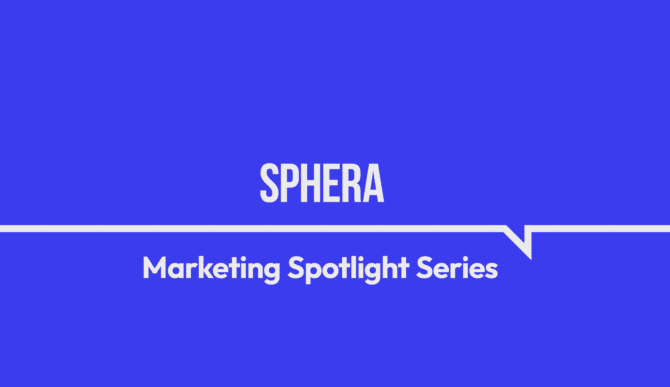Marketing Spotlight: Mapping ClickUp’s Marketing and Sales Strategy
Article summary
Share
Every team today relies on at least a couple of project management tools. From calendars and chats, to task tracking and visual planning, they are managed often across different apps. This can lead to chaos, confusion, missed deadlines, and way too many clicks. So why juggle multiple platforms, when you could use just one designed to keep everything, and everyone, on track?
At Milk and Cookies Studio we believe in keeping things simple, efficient, and effective. We’re always on the lookout for better solutions that work both for us and our clients, all while staying within budget.
As a solution, ClickUp promises to deliver the best all-in-one project management tool today, boosted by AI capabilities.
Their latest funding round for this California-based company, closed in October 2022 at $400 million, valuing the company at $4 billion, with plans to expand further into Europe.
So, what sets ClickUp apart? Much like their platform, their marketing approach is broad and varied. They create educational content, viral funny videos, and clever comments at competitors, rather than focusing on just one rival.
Curious how they turned a crowded market of project management software into their launch pad? Let’s unpack together ClickUp’s marketing and sales strategy.
📝 A quick note before you start reading:
The data and analysis in this article are valid as of the time we wrote it. We don’t know when you’ll be reading this, maybe next week, maybe six months from now, and things might have changed since we looked at this company’s marketing and sales approach. Still, the insights and lessons here stay useful, even if the numbers or tactics have evolved a bit.
Understanding ClickUp
ClickUp is a project management software company, founded in 2017 by Zeb Evans and Alex Yurkowski. What started as a simple internal productivity tool, quickly evolved into a cloud-based platform, designed to help teams of all sizes organize, collaborate, and get work done more efficiently.
Headquartered in San Diego, California, ClickUp has since expanded with offices across the United States, Canada, Ireland, the United Kingdom, Australia, and beyond. Today, the company employs around 1,000 people and has approximately 1,424 associated members.
ClickUp offers an all-in-one work management platform that brings together tasks, documents, chats, whiteboards, spreadsheets, and AI-powered features, eliminating the need for multiple separate apps. Its flexibility makes it a favorite across industries, from software development, to marketing, human resources, and business operations. Big names like Cartoon Network, Chick-fil-A and Stanley count themselves among its clients.
Brand Promise Analysis
ClickUp leads with a clear brand promise right on their homepage: “The everything app, for work.” This tagline sums up their mission to simplify how teams work by bringing project management, documents, chats, goals, and more under one roof, freeing users from the hassle of switching between multiple tools.

ClickUp positions itself as a productivity hub that adapts to any team or industry, letting users “work how they want”, without compromise. Their argument? Constantly switching between apps fragments focus, wastes time, and kills productivity. They aim to fix that by bringing together over 50 different apps into a single platform.
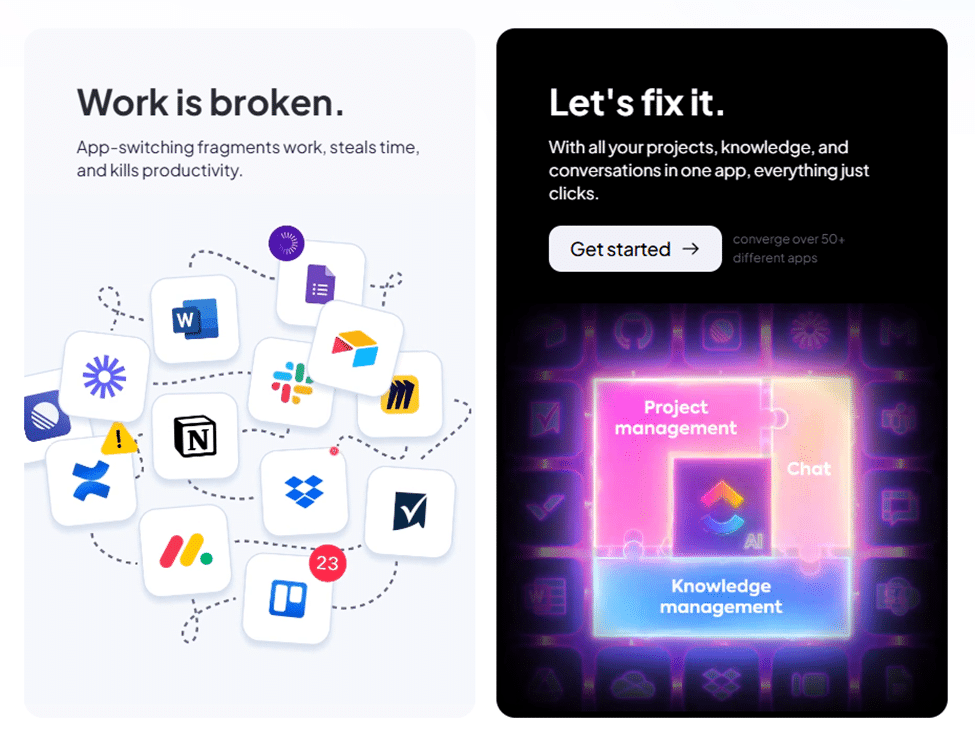
The platform promises an all-in-one workspace where you can tackle your most important work faster, backed by over 100 features designed to boost productivity.


Across their homepage and product pages, ClickUp leans heavily into themes like seamless convenience, scalability for teams of any size, and ongoing innovation powered by AI. They highlight features such as: customizable workflows, native integrations, and real-time collaboration, all reinforcing their promise to help users “get more done” with less friction.


ClickUp’s communication style splits in two tones. One is approachable and easy to understand, used for product description. The other is confident, witty and sometimes playful, especially when poking fun at competitors.
On their About Us page, the mission centers on having all work live in ClickUp, helping people reclaim at least 20% of their time. They even use some nerdy, adapted phrases like “One app to replace them all” and “Save people time by making the world more productive”. This down-to-earth and relatable approach helps them stand out, especially compared to other apps that often go for a more sterile, professional voice. After all, who says work can’t be fun?


Looking at their Core Values, we see that the company encourages its team to work hard, but enjoy the process along the way.

Visually, ClickUp’s brand identity it’s vibrant yet easy to digest. They rely on bold purples and whites, colors that evoke creativity, inspiration, and trust. For accents and smaller details, they use the full rainbow specter, emphasizing their complex nature and broad appeal.
Clean, modern fonts and plenty of white space keep everything easy to read, while illustrations and UI screenshots scattered throughout the site add a friendly, dynamic feel.

Altogether, their brand sends a clear message: they’re not just offering tools, they’re transforming how work gets done around the world.
Service and Product Breakdown
ClickUp offers a comprehensive suite of products designed to serve as a one-stop platform for managing all kinds of work. Their solutions cover a wide range of productivity needs, with flexible options tailored to teams of every size and industry.
They focus on two main products: the all-in-one project management tool, and Brain, their AI-powered solution that integrates multiple tools seamlessly.
The core management platform brings together a variety of features, such as:
- Tasks
- Projects
- Docs
- Automations
- AI-powered tools
- Dashboards
- Reporting
- Resource and time management
- Collaboration tools like chats, comments, proofing, and annotation
- Project views
- Integrations and APIs
- Additional features, like whiteboards for brainstorming, portfolios for overseeing multiple projects, goal tracking, spreadsheets, forms and meeting management
Their website navigation breaks into five main categories: Product, Solutions, Resources, Pricing and Enterprise.

Within the Product tab, you can explore Capabilities, All Features and Integrations.
The Capabilities section is further divided into areas like Project Management, Product Development, Knowledge Management, Resource Management, Collaboration and Workflows. Each has its own detailed landing page that helps you understand exactly how ClickUp fits your specific needs.
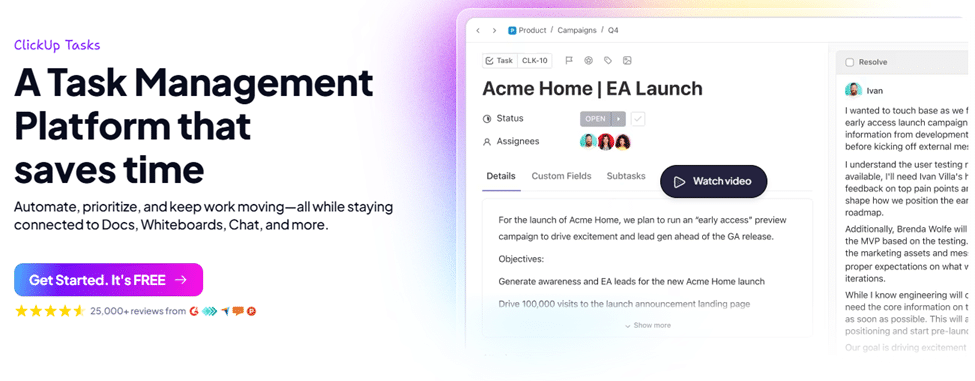

The features tab showcases a vast and continuously growing selection of tools, with new releases arriving regularly.

Under Integrations, you can find a list of many tools ClickUp connects with, promising a smooth migration that takes just minutes.


The Solutions tab offers tailored offerings organized by department via Team and Templates, and also helps determine which options best suit your company size through the Type category.



On the Pricing page, ClickUp presents multiple tiers starting with a Free Forever plan that includes unlimited tasks and integrations for individuals or small teams. From there, pricing scales through Unlimited, Business, and Enterprise plans, each unlocking more advance capabilities.

Strategically placed call-to-action (CTA) buttons “Get Started” or “Contact Sales” guide potential users toward conversion. Alongside this, testimonials and case studies are displayed to build trust and showcase real-world impact.


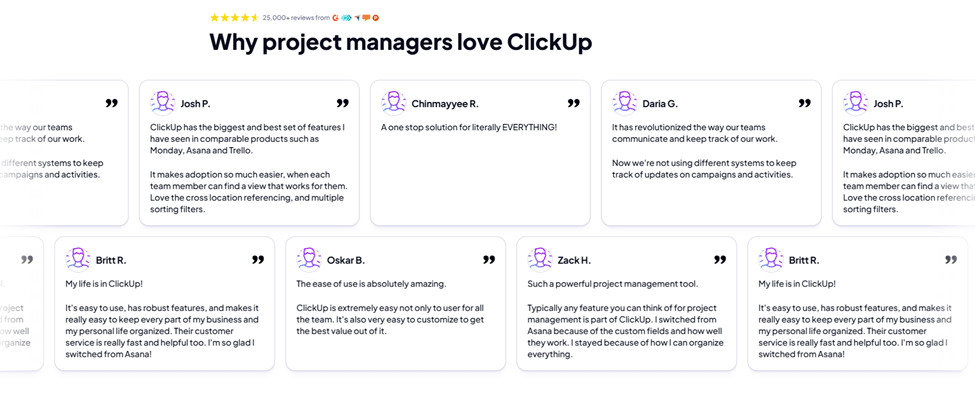
ClickUp builds urgency and addresses cost concerns with confident messaging, offering a 100% Money-Back Guarantee, proven cost-saving benefits, and tangible client results.



This modular and comprehensive approach allows ClickUp to position itself as a fully customizable work management ecosystem that evolves with its customers.
Brain
ClickUp’s Brain promises to be the only AI that works where, with, while, and how you work.

They claim it can save you one day a week, complete tasks three times faster, and reduce costs by 86%.

Brain lets you offload busywork to AI agents and assistants, run autonomous projects without micromanagement, free your team from note-taking, scheduling, and status updates, and accelerate creativity.
One standout feature, Talk To Text helps save time by generating meeting notes, follow-up emails and video scripts up to four times faster without typing.
You can search across all your tools and apps securely, with no third-party data training or retention involved, delivering enterprise-grade peace of mind.

Like their core project management platform, Brain offers a Free Forever plan alongside paid options like AI Standard and AI Autopilot. Users can also opt out for paid add-ons such as Talk To Text and AI Notetaker.


Differentiators and Unique Assets
In a crowded project management market, ClickUp manages to stand out by doing more than just offering standard software. Their all-in-one platform, combined with an integrated AI tool, gives them a notable edge in the industry.
Beyond these core offerings, they provide free resources aimed at supporting their users and peers. These include ClickUp University, demos, video tutorials, webinars, articles, and virtual summits.
ClickUp University deserves special mention; it’s a comprehensive learning platform designed for users at every level, from those just starting to explore project management basics to advanced users mastering advanced automations and integrations. Most of this content is free, reflecting ClickUp’s commitment to customer success and continuous education.

The community aspect is another strong point; users from around the world connect to exchange tips, troubleshoot workflows, and spark creativity. They even maintain an active Reddit presence where users can share feedback, ask questions, and discuss their experiences with the software.
Another clever resource is their Productivity quiz, developed in partnership with research firm IDC. By answering 15 questions, users can discover their productivity stage and receive detailed action plans to improve. This quiz is a smart SEO play as well, ranking on Google’s first page for “productivity test”.

Naturally, users want to compare options, and ClickUp leans into that with a witty, no-holds-barred approach. They don’t shy away from highlighting competitors’ flaws while positioning themselves as the clear alternative. By the time you finish browsing, you might just find yourself ready to “join the dark side” and download ClickUp.

They pull no punches when discussing rivals like Monday, Notion, Asana, Jira, Trello, Slack, MS Project, Smartsheet, Airtable, Basecamp and Todoist. Often in a tone resembling a schoolyard bully, they will be calling out flaws with funny statements. Some competitors have even tried to adopt a similar cheeky style, but it hasn’t quite clicked for them. ClickUp’s fresh and playful voice sets it apart in a way more serious platforms can’t match, like a diss track that never left the studio.



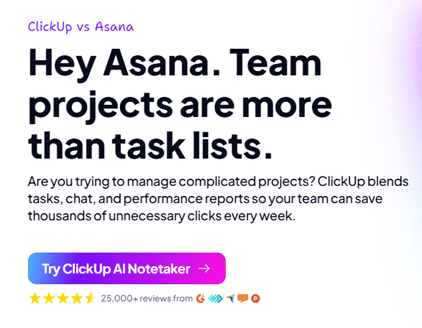
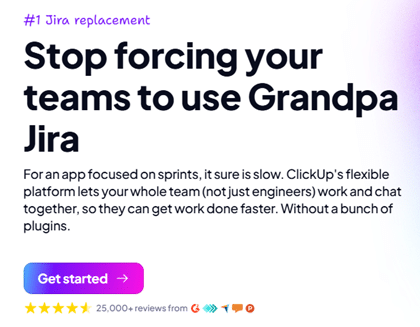

In conclusion, ClickUp lowers buyer hesitation by flooding prospects with educational content, sharp humor, and a strong, engaged community.
Leadership Presence Analysis
For ClickUp, the leadership presence on LinkedIn gives a mixed view of personal branding and social engagement among its top executives, offering insights into their communication style and influence on the platform.
Zeb Evans, the Founder and CEO of ClickUp, has over 40k followers on LinkedIn. His profile reflects a strong entrepreneurial spirit with a clear mission focused on productivity. He shares insights about ClickUp multiple times a week, gathering solid engagement, with typically around 200 reactions per post, along with comments and reposts.
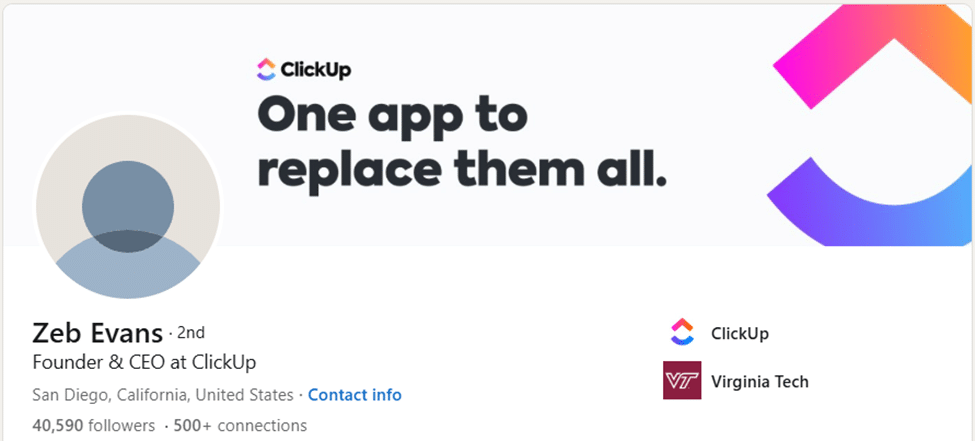
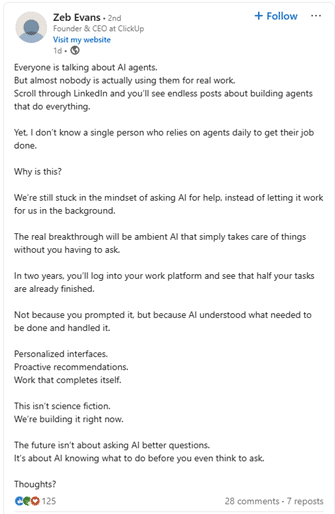

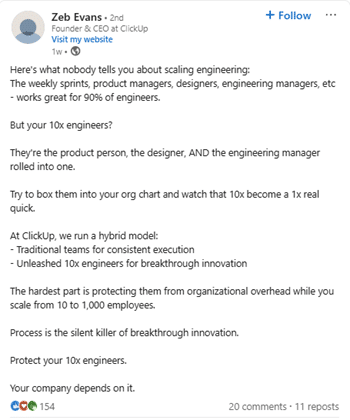
Kyle Coleman who stepped in as a Global VP of Marketing in April 2025, boasts a larger following of 136k. He posts roughly once a week, often sharing career insights that wrap up with a CTA phrase like “Care to join?”. His posts receive around 100 reactions and tend to draw more comments and reposts than Zeb Evans’ content.
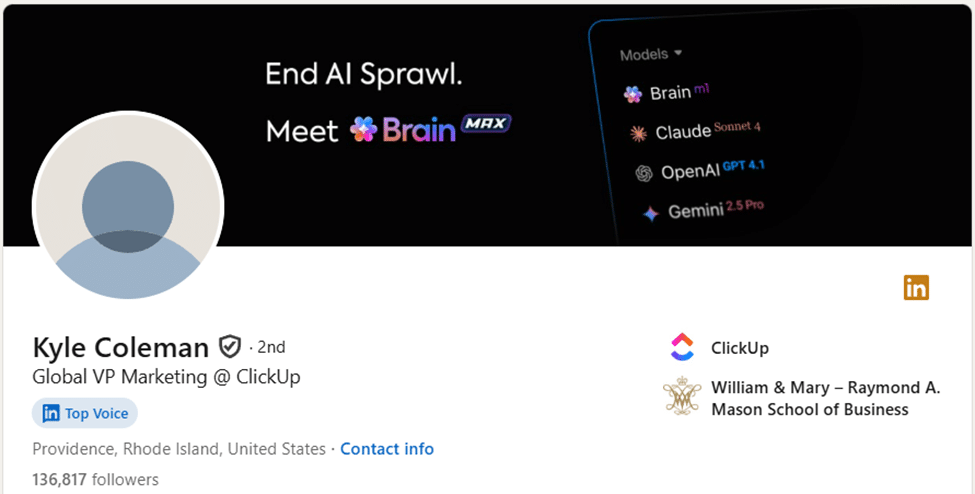
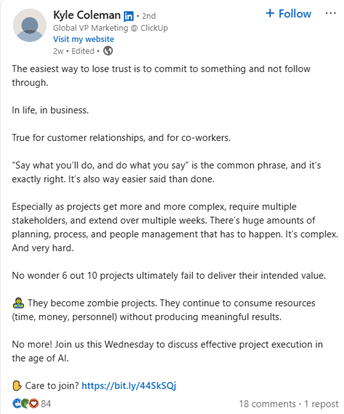
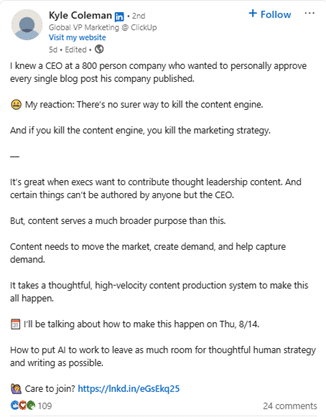
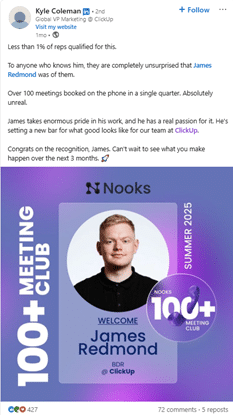
Chris Cunningham, a founding member of the marketing team, has about 20k followers. The person behind all ClickUp’s social media content, posts daily, sharing mostly about ClickUp and professional insights. While his engagement varies widely, from 30 reactions on some posts to over 200 on others, he consistently includes call-to-action encouraging followers to connect for more B2B marketing content.
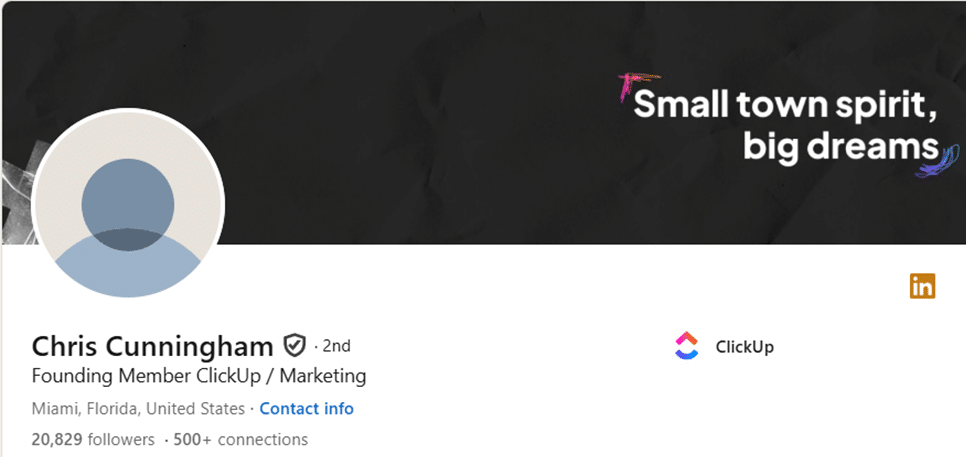


So, what’s the takeaway? Even individuals can drive company growth through personal branding. Sharing insights, thoughts on products, and highlighting team members is a powerful strategy, especially since there are many companies that look stiff and untouchable from the outside. Building personal presence in platforms like LinkedIn can help you gain traction, increase sales, and boost your reputation.
Social Media Strategy
Think an all-in-one platform like ClickUp wouldn’t be on every major social media channel? Think again. They’re active across Facebook, Instagram, TikTok, LinkedIn, Youtube and X (formerly Twitter).
Unlike many brands that simply repost the same content across platforms, ClickUp tailors its content to fit each audience. They even run a separate account called ClickUp Comedy, dedicated to funny workplace videos, which we’ll explain soon.
Let’s break down their online presence by platform and explore their social media marketing strategy.
ClickUp’s LinkedIn company page has around 242k followers and maintains a steady stream of posts, often multiple times a week.

Engagement varies widely; some posts rack up thousands of reactions, while others barely hit a couple dozen.


Their content mix is impressively diverse, from educational posts and product updates, to engaging, lighthearted videos. They also run interactive polls, detailed tutorials, and employee takeovers, to create an active, varied presence.
This versatile approach works: it broadens their reach by appealing to different interests. Focusing solely on educational content might eventually lose the younger crowd, while only funny content could undermine their credibility as a serious brand. By blending both, ClickUp keeps their audience engaged.
With 95k likes and 151k followers, ClickUp’s main Facebook Page posts multiple times a week, sharing product news and comedy content.

Engagement rates on this platform are low, with around 10-20 likes per post and few comments or shares. It’s clear that Facebook isn’t their primary battleground, unlike LinkedIn where they post more frequently.

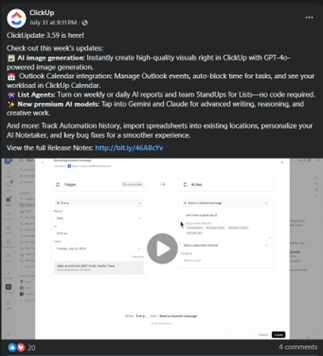
They also manage ClickUp Comedy page, posting only humorous workplace videos. Every comedy post tags both pages, smartly driving attention back to the main product. Given Facebook’s current video-focused browsing and shrinking attention spans, this approach helps keep them relevant.
ClickUp Comedy page has 5.1k likes and 17k followers, grabbing slightly more engagement than the main page, though still modest compared to dedicated content creators.
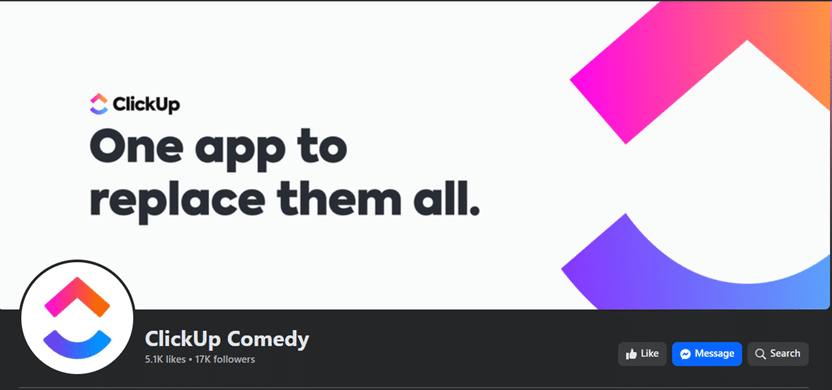
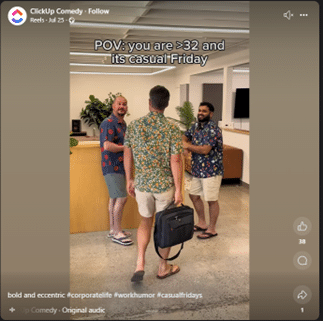
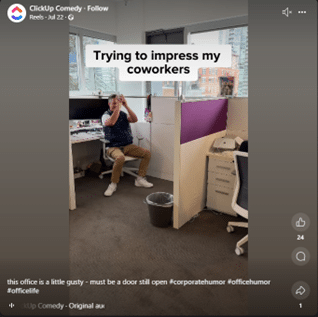

Similar to Facebook, ClickUp operates two Instagram accounts: the official one with 369k followers, and the comedy account with 256k followers.
The numbers are stronger here, as Instagram remains a top “doomscrolling” platform. The main account mixes funny videos with some product updates, while the comedy account sticks too, well, comedy.
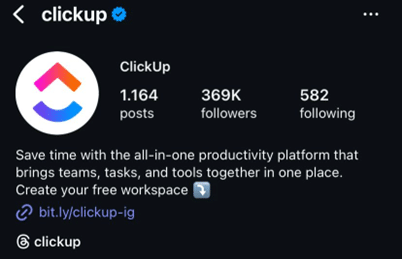
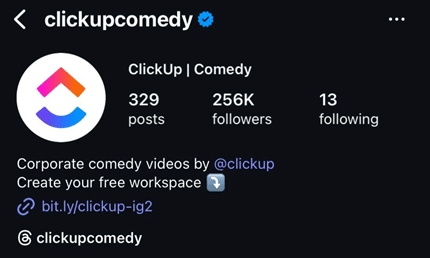
They regularly rack up millions of likes, thousands of comments, and millions of shares. If you use Instagram, chances are you’ve come across some of their top posts in your feed.
X (formerly Twitter)
Surprisingly or not, they’re active on X as well, with about 68.8k followers.
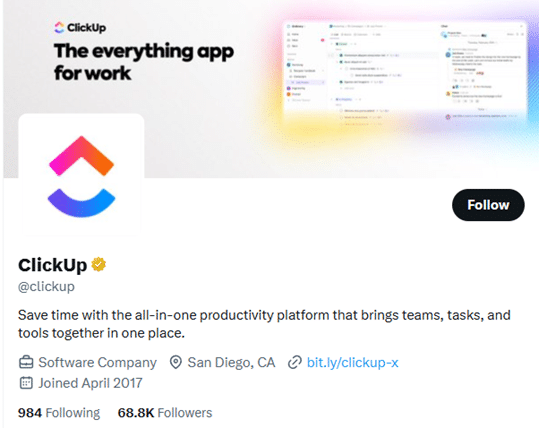
The content overlaps with what’s on Facebook and LinkedIn, but includes questions and prompts designed to spark engagement.

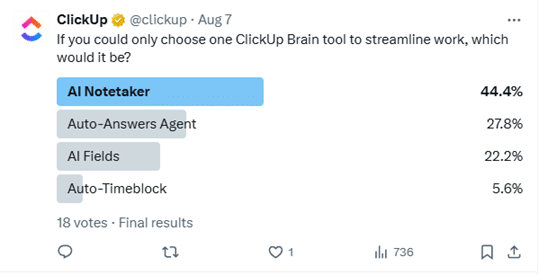
Youtube
With 87.7k subscribers and over 1k videos, ClickUp’s Youtube channel is a mix of long-form content and shorts.
They’ve adapted well to the platform’s shifting trends. Their shorts, focused on user experience, pull in thousands of views but relatively few likes and comments. Longer videos mostly consist of demos and tutorials, with views ranging from around 600 to nearly 7,000.
They also produce a podcast called When It Clicked, which had 5 episodes as of August 2025, releasing new episodes roughly every two weeks.
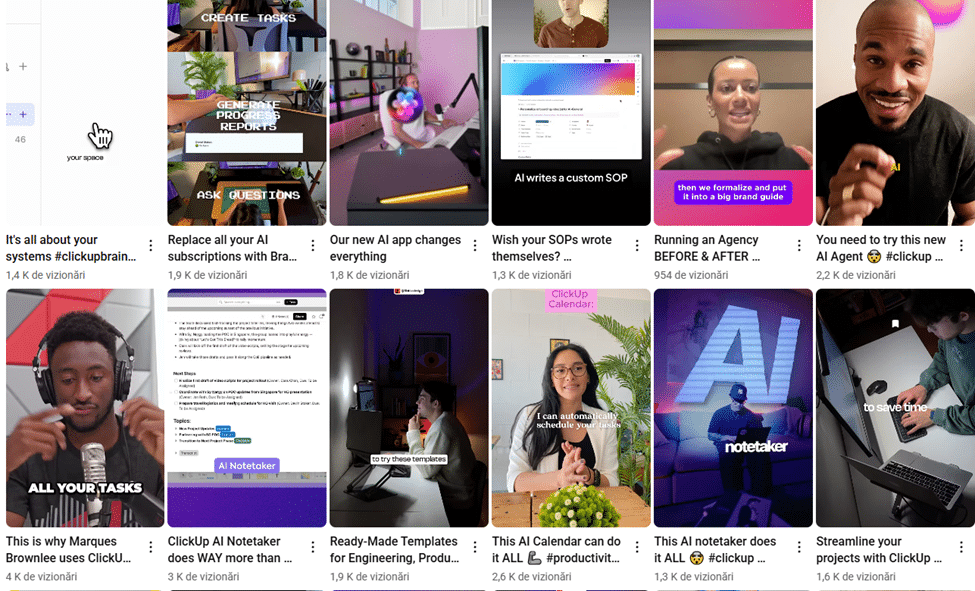
TikTok
TikTok is where ClickUp really shines. Their account has 383.3k followers and over 10.9 million likes. As their bio says, it’s “Actual footage of the corporate world.”
Their engagement rate is strong for a brand on TikTok. The platform’s algorithm pushes content based on what users relate to, which often means dance influencers or ads. ClickUp, however, focuses on organic reach, connecting with people who appreciate their sense of humor.
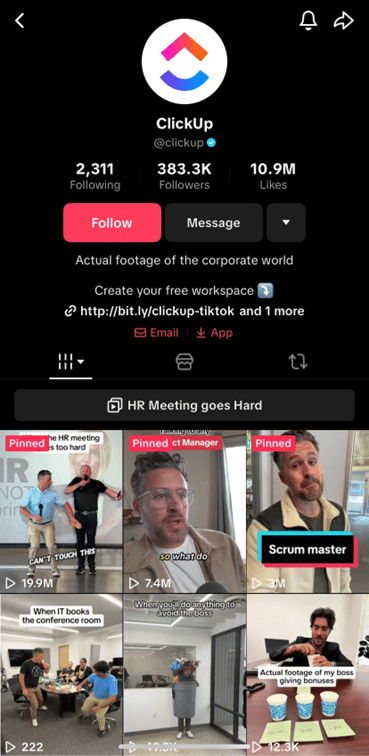
Conclusions
ClickUp is building connections across the social media landscape, gaining some traction on Facebook and X, more on Instagram, Youtube and TikTok, and steadily growing their broader brand identity.
The care and effort they put into tailoring content for each platform is impressive and worthy of recognition. What can we learn? Even a big player can grow even bigger by winning over smaller audiences piece by piece.
By showing up where competitors haven’t, like TikTok, they claim first-mover advantage and plant themselves firmly in the minds of users for the long haul.
Top-Performing Content
In this section, we take a look at ClickUp’s most engaging content across their social channels.
For LinkedIn, video posts clearly come out on top. Whether announcing a new product or sharing a lighthearted skit, videos tend to generate much higher engagement than regular posts.
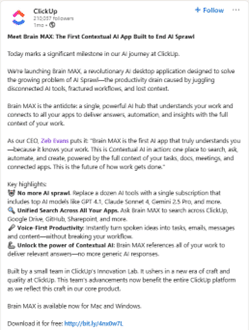
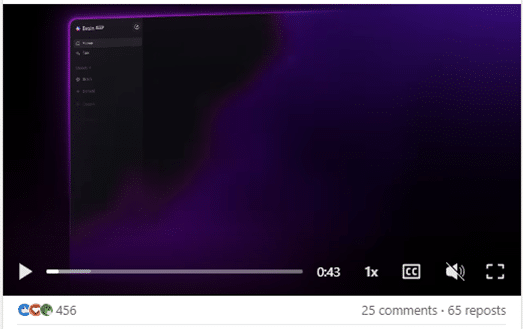
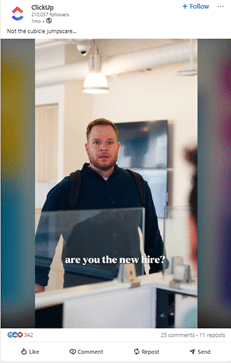
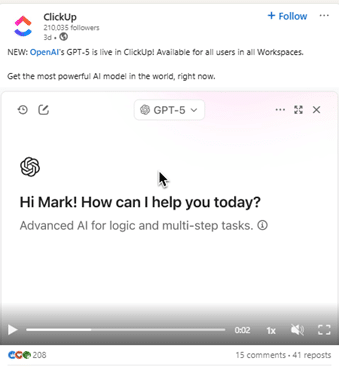
ClickUp’s official Facebook page, however, struggles to gain traction. With only 10-20 likes per post and the occasional comment, it’s clear that isn’t their primary platform. Among the content types, carousels perform slightly better, but nothing has gone viral.
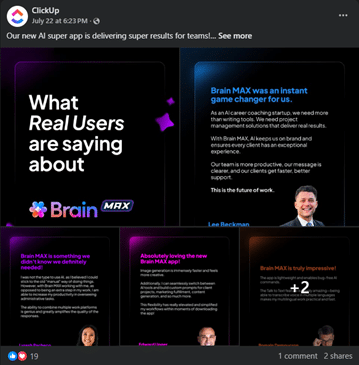
The ClickUp Comedy Facebook page fares a bit better, with some videos hitting around 1k likes, though most don’t reach high popularity.
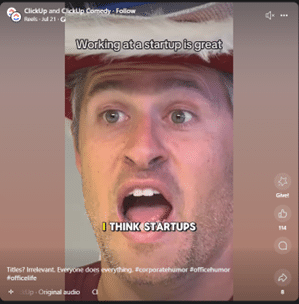
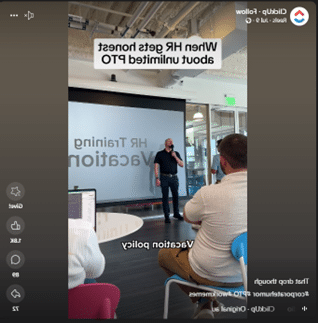
On X (formerly Twitter), posts rarely exceed 1k views and get modest likes and comments.
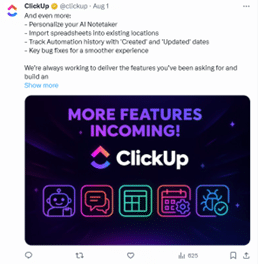
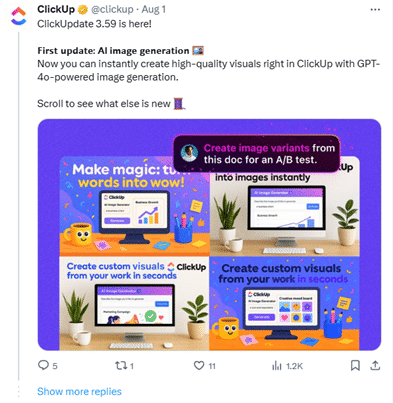
The real impact starts with Youtube, Instagram, and TikTok, where ClickUp’s shines across the board and consistently pulls engagement.
On this platform, top performing content are videos, especially the funny ones, like mentioned before. As we can see from the examples below, they scored even 1.3 million likes, 9.4k comments, and 1 million shares.
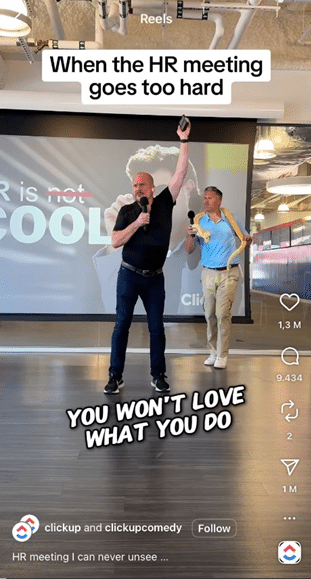
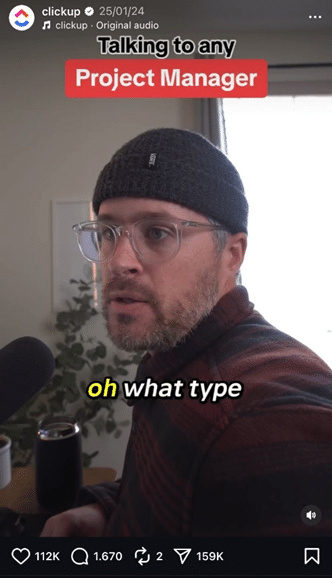
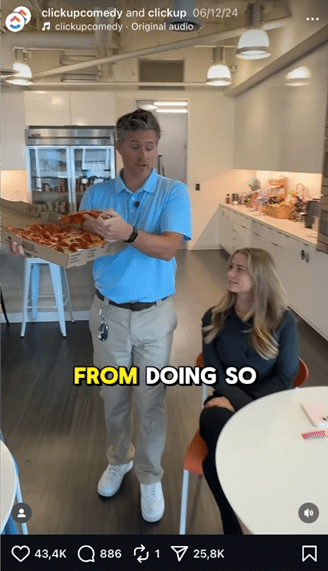
Tiktok
ClickUp avoids jumping on popular dance or silly trends. Instead, they rely on original content and workplace humor that resonates with their audience, and it clearly shows, with 19.9 million views, 1.9 million likes, 14.6k comments, 188k saves and 978k shares.
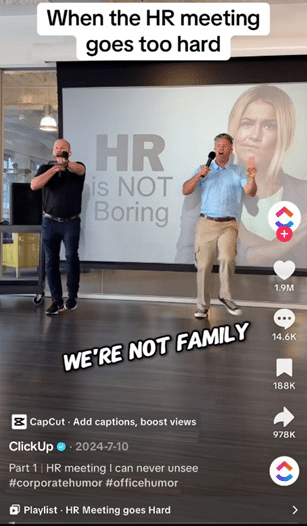
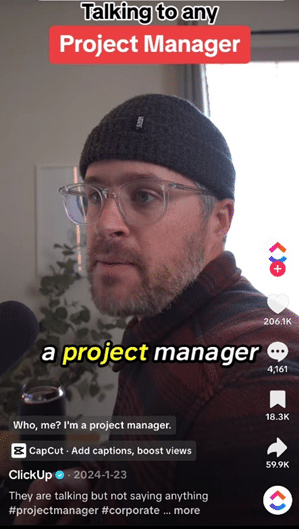
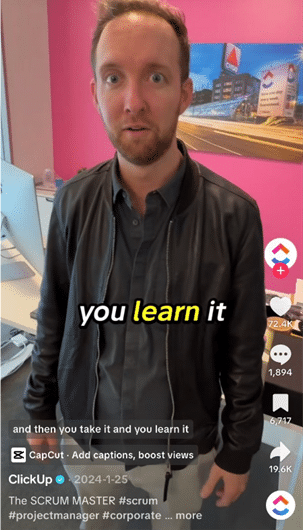
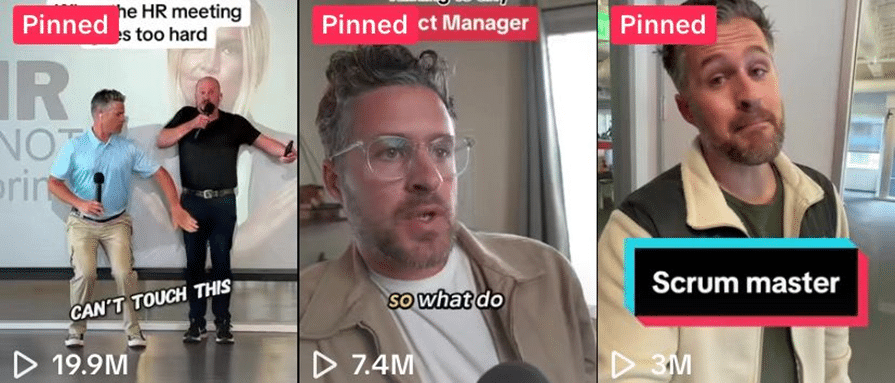
Youtube
Some of their top videos include:
- BEFORE Click Up vs AFTER ClickUP|Monica – with 23m views, 2.8k likes, and 124 comments
- BEFORE Click Up vs AFTER ClickUP|David – with 9.8m views, 1.8 likes, and 88 comments
- Clickup | Whiteboard | Permanent marker – with 7.3m views, 183 likes, and 52 comments
These videos primarily serve as commercials promoting either the app in general or specific features, like Whiteboard.

In summary, ClickUp leans heavily on video content across platforms, understanding that it drives the highest engagement and helps connect with their audience more effectively.
Sales Funnel from Social Media
A look at ClickUp’s social media shows a clear pattern: most platforms and posts include links that direct users to their website. From there, visitors can download the app or find detailed information about specific products and features.
Instagram and TikTok stand out as exceptions. These channels focus purely on content with no direct conversion tactics. No links, no CTAs, making them their “fun” channels.
On Youtube, links are placed in the video descriptions, guiding viewers toward the next step.

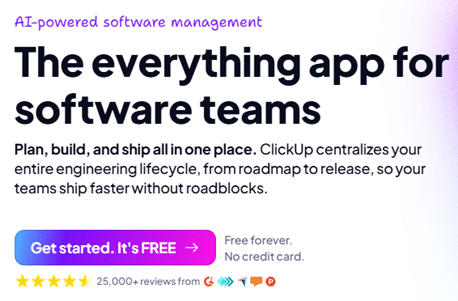

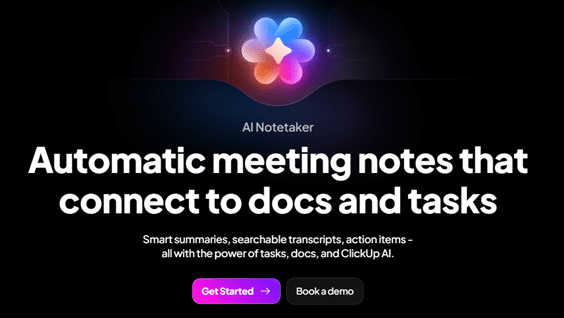
Facebook also includes links in post captions, but only on their main page and not as frequently as on Youtube.
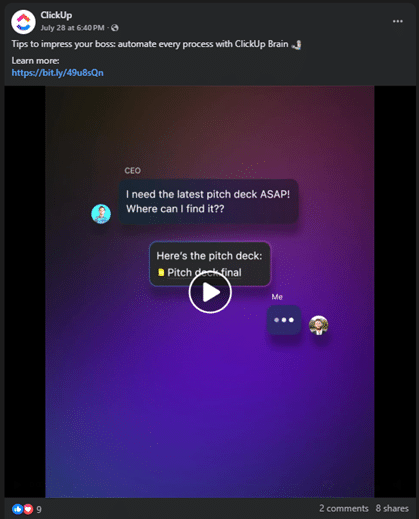
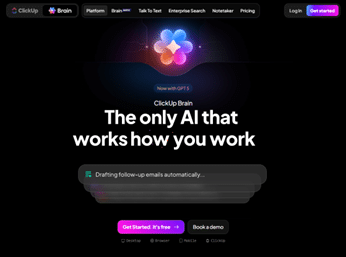
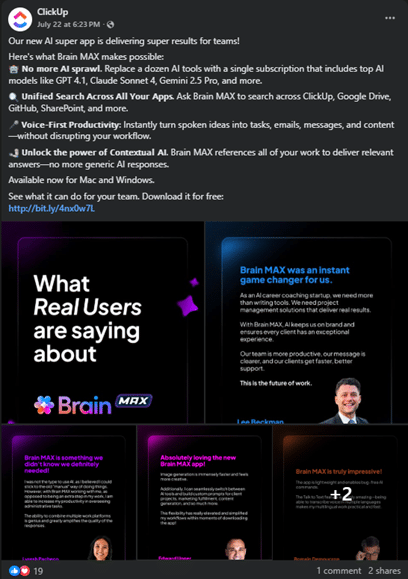
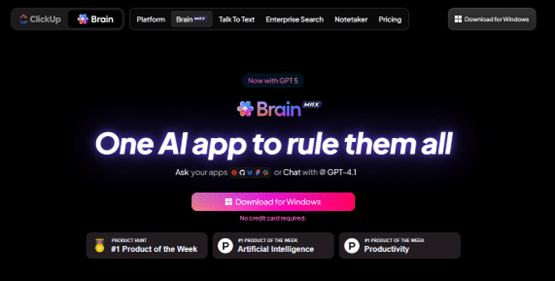
LinkedIn follows the same approach, with just a few links directing users to targeted landing pages.
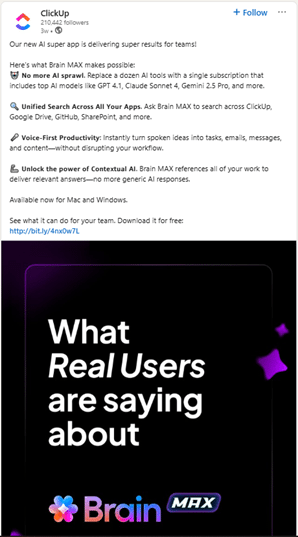
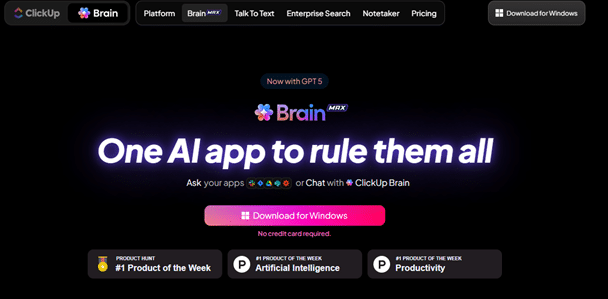
Paid Advertising Strategy
ClickUp doesn’t promote their regular posts. Instead, they create entirely new ads with other visuals. Their LinkedIn ads fall into two main categories: those driving product downloads and customer review testimonials.
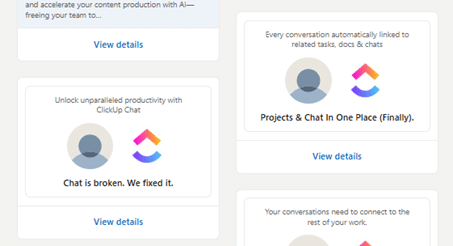
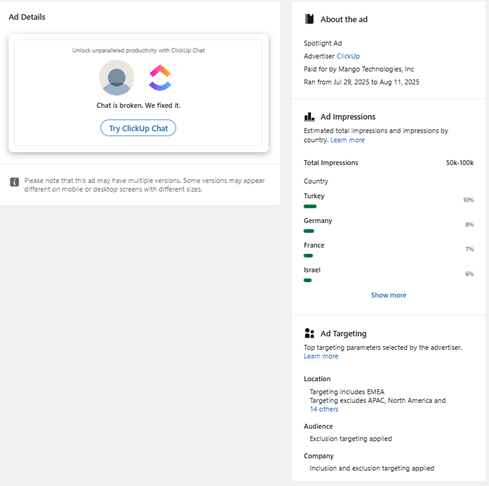
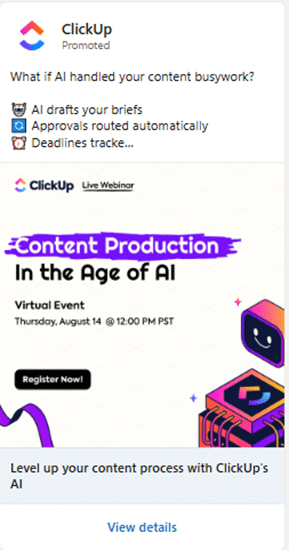
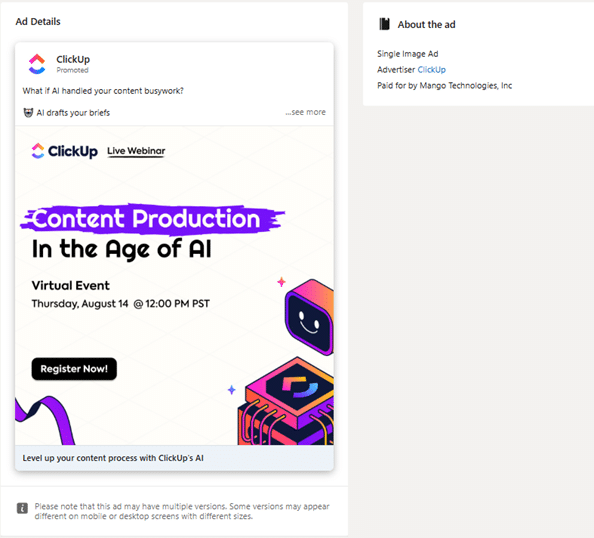
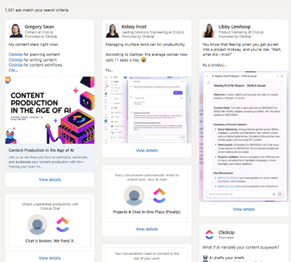
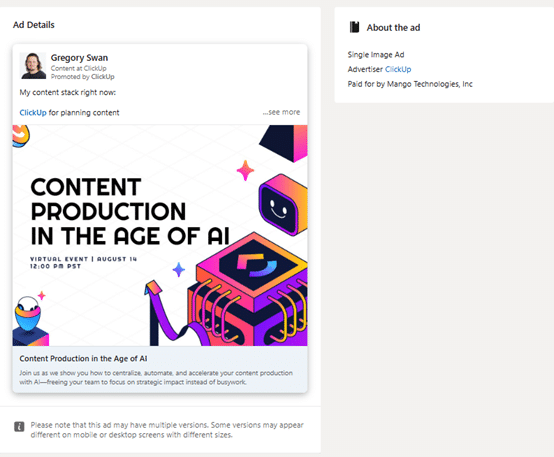
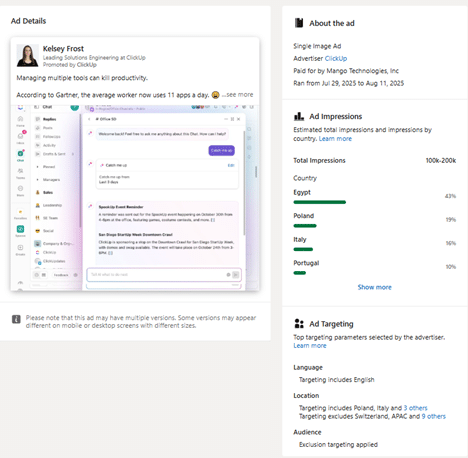
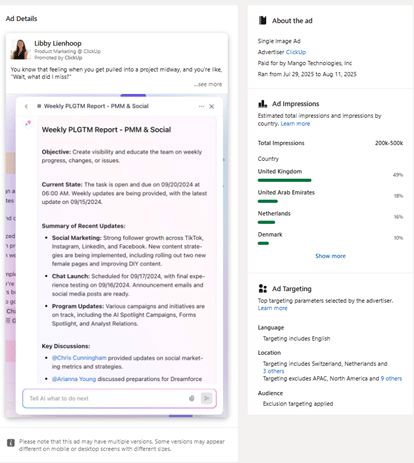
Meta (Facebook, Instagram, Messenger)
On Meta platforms, ClickUp leans heavily on commercial-style videos for advertising. These ads run across Facebook, Instagram, and Messenger. Clicking any of these ads takes you straight to their website, consistent with how they handle links across all their social media captions.


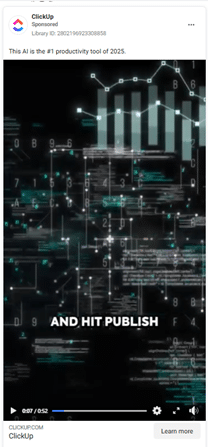
Reviews and Social Proof
This is where things get a bit controversial. While ClickUp proudly showcases on their website that they’re trusted by major companies and countless teams worldwide, a closer look at recent reviews on social media and Reddit threads reveal a number of complaints about bugs and app issues.
On G2, ClickUp holds an excellent rating of 4.7 out of 5 stars based on over 10,000 reviews. Users frequently praise its flexibility to adapt to different teams and workflows, its comprehensive all-in-one features that reduce app switching, and frequent product updates that continuously improve the platform. Many appreciate ClickUp’s powerful customization and automation options, as well as its ability to centralize work and communication. However, some new users warn about a learning curve due to the platform’s feature-rich platform.

Capterra gives ClickUp a rating of 4.6 out of 5 stars from more than 4,000 reviews, with similar positive feedback on usability, integration options, and customer support. Users often highlight how ClickUp saves time by streamlining collaborative tasks and project management.

Trustpilot paints a less rosy picture, with a significantly lower score of 2.4 out of 5 stars from 345 reviews. Recent customer commers there point to ongoing concerns.

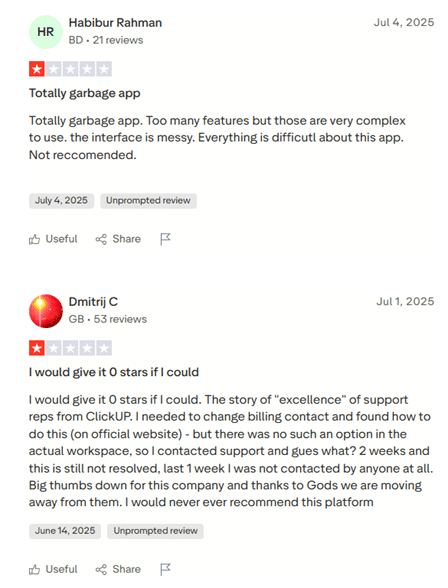
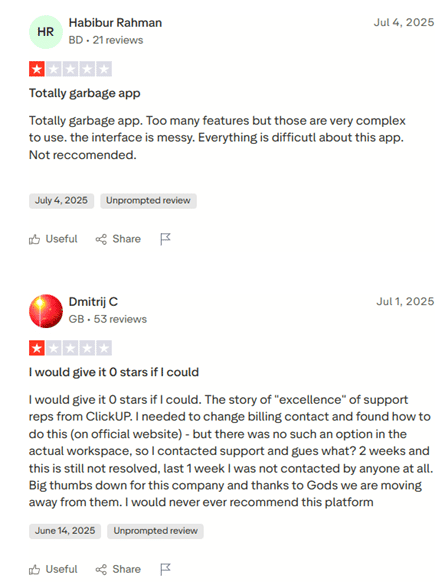
Other ratings:
- Software advice: 4.6/5

- Trust Radius: 8.6/10

- GetApp: 4.6/5

- Google play: 4.4/5

- Apple Store: 4.6/5
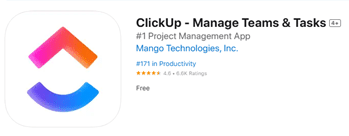
- Facebook: 86%/100%

Various articles and Youtube reviews also mention areas ClickUp needs to improve, including:
- Ease of use, with complaints about a complex user interface
- Customer support, noting the lack of 24/7 live assistance
- Slow performance speeds
- Bugs in the mobile app
- Finicky time tracking features
- No integrations for payroll or accounting software
- Inconsistent bug fixes
While ClickUp clearly has a loyal user base, these challenges highlight areas where the company still has room to grow.
Content Marketing and Demand Generation
ClickUp offers a varied selection of free resources, including videos, webinars, articles and virtual summits.
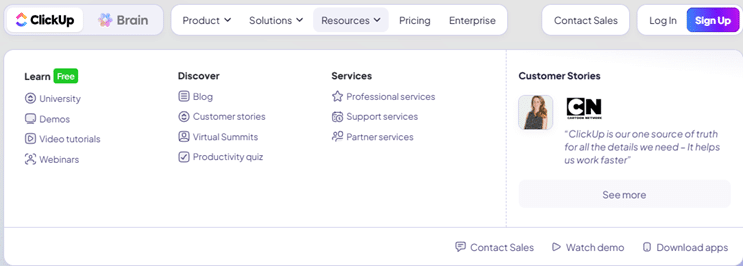
Their educational videos aim to simplify the onboarding process by answering common questions, such as how to use different features effectively.

Webinars provide powerful tips and deep-dive training sessions designed to help users maximize productivity. They are linked to their Youtube channel, where an even wider range of topics is available.
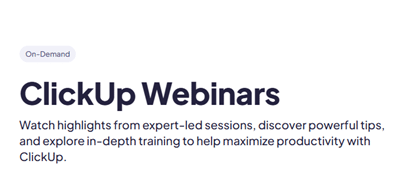
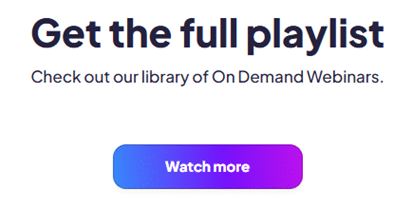
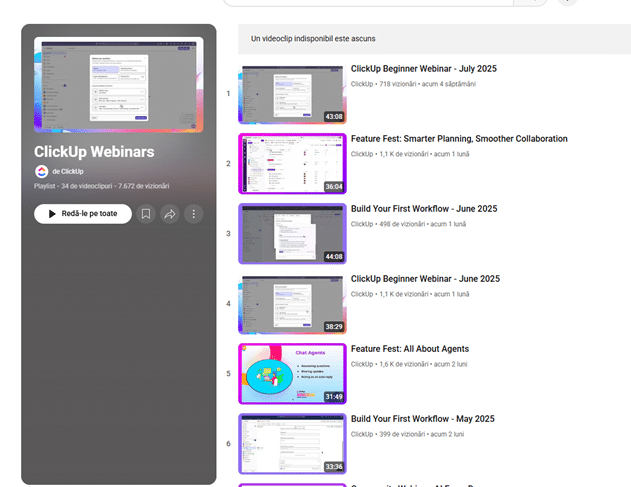
Regarding their Virtual Summit, the latest edition featured speakers from companies like OpenView, Deel, Miro, and Lids. Interested users can sign up to access all session recordings through a simple contact form.
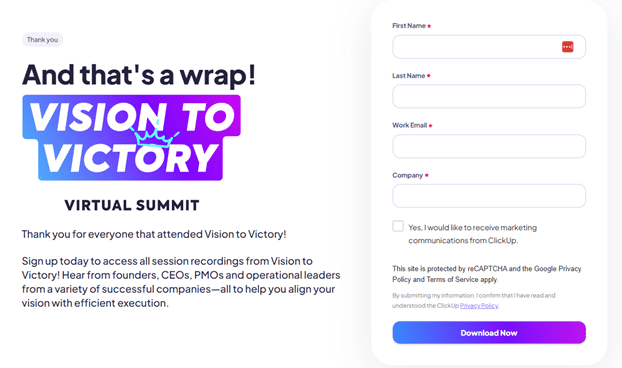
ClickUp’s blog is packed with engaging articles, some even penned by CEO Zeb Evans himself. Each article clearly shows the author’s name, adding a personal touch that humanizes the brand.
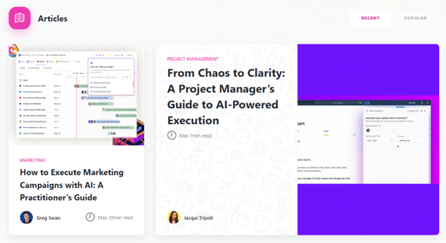
In article previews, you’ll find estimated reading times, and throughout the posts, social sharing buttons make it easy to share content on platforms like X, LinkedIn, Facebook, and beyond.
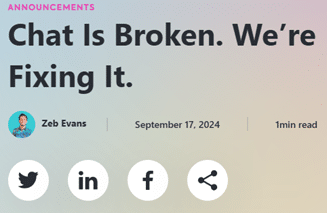
While ClickUp posts to their Blog sporadically, they focus on tutorials and how-tos. The blog currently hosts only four insight articles, surrounded by mostly educational content, which visitors can subscribe to through a newsletter.
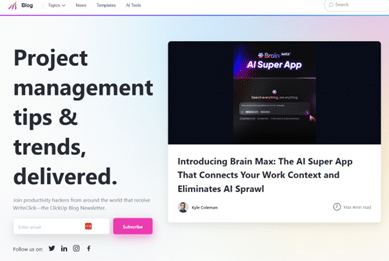
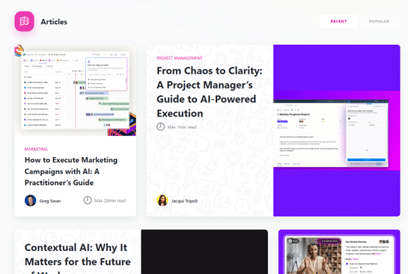
On each blog post page, you’ll find clear details about the article’s length and author, along with multiple “Get Started” buttons encouraging conversions.
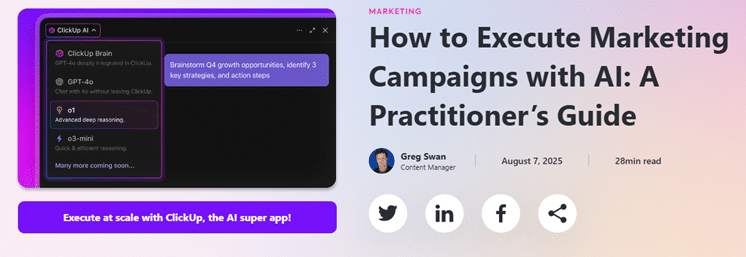
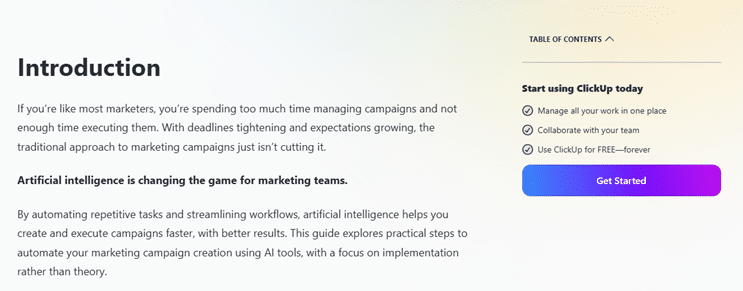
The articles themselves make a good use of emojis, hyperlinks and visual content, all of which help make the reading experience more enjoyable.

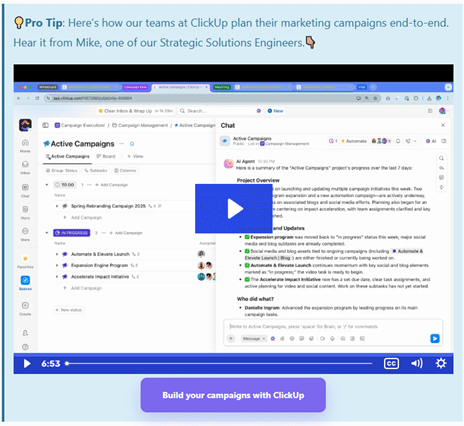
Marketing and Sales Funnel Stages
Top of Funnel: Awareness and Entry Points
At the very top, ClickUp casts a wide net to build brand awareness and drive traffic to their website. This stage relies heavily on social media posts featuring clear calls-to-action like “Get your free trial” or “Learn more”. Their content mix includes engaging videos, blog posts, webinars, and light-hearted vlogs designed to appeal to a broad professional audience. The focus here is to spark curiosity, build trust, and attract new visitors without applying heavy sales pressure.
Middle of Funnel: Nurturing and Lead Magnets
Once prospects show interest, ClickUp moves into nurturing mode with more detailed content aimed at educating and guiding leads closer to conversion. This includes downloadable templates, detailed guides and case studies that showcase the platform’s value and versatility. Many of these resources are gated, meaning users provide contact details, in order to enter.
Bottom of Funnel: Demo Requests and Sales Conversations
At the bottom of the funnel, ClickUp’s streamlines demo bookings, offers personalized sales interactions, and uses data-driven follow-ups to close deals efficiently while maintaining a customer-focused experience. This strategic coordination between marketing and sales ensures no leads slip through the cracks as interested prospects become long-term users.
Lead Generation Mechanisms
ClickUp leverages multiple lead generation tools such as newsletters packed with tips and updates, free templates to kickstart projects, and educational webinars. These resources nurture potential customers by providing value, creating a helpful rather than pushy relationship.
The Sales Funnel
Leads typically enter organically from website conversion (trials, demos). Sales progress through clear subscription tiers, from the Free Forever plan to the Business plan. For enterprise clients, personalized quotes require contacting the sales team directly.
In conclusion, ClickUp’s funnel strategy revolves around being is all about being everywhere, at all times, ensuring they’re the first name prospects think of when it comes to productivity solutions and task management.
Future Plans and Growth Indicators
ClickUp is actively signaling strong growth and ambitious plans for the future, noticable it its hiring trends, product development roadmap, and strategic expansions.
Current Job Openings and New Roles
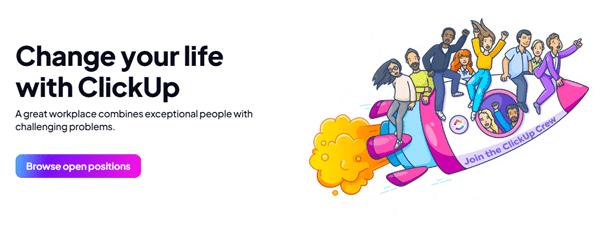
A look at ClickUp’s careers page and LinkedIn Jobs shows ongoing recruitment aimed at scaling key departments such as customer experience, engineering, executive, finance, growth, IT, legal, people, product development, sales, and support.
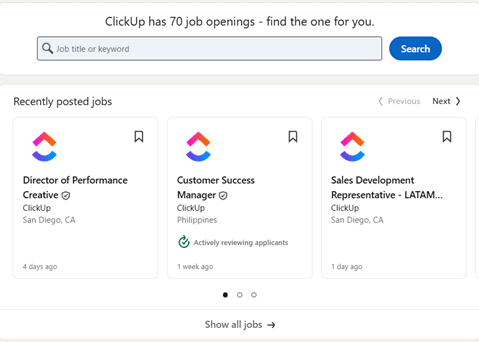
The jobs can be filtered by location and shows offices in Bulgaria, Canada, Czechia, Hungary, Ireland, Philippines, Poland, Ukraine, the United Kingdom and the United States.
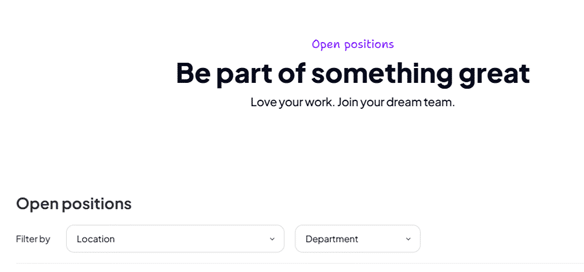
Expansion Plans and New Market Entry
ClickUp is broadening its global footprint with regional offices in key markets such as Europe, Australia, and the United States to better support its increasingly international user base.
Their growth strategy includes a clear push into the enterprise sector, with advanced offerings focused on enhanced compliance, security, and customization; areas highly valued by larger organizations. This reflected in their premium pricing plans and tailored services designed to meet complex business needs.
Additionally, ClickUp’s investment in AI-powered featured and educational resources, such as ClickUp University and their Virtual Summits, shows ongoing commitment to innovation and customer success. By combining product development with aggressive hiring and market expansion, ClickUp is positioning itself for sustainable, long-term growth.
Inspiration Points
ClickUp’s success offers several valuable lessons for marketers:
- Show up everywhere. Being present on all major platforms ensures you reach your audience wherever they are.
- Add some humor. A bit of comedic relief can get users through the workday and even encourage app downloads because it feels relatable.
- Build a passionate community. Cultivating and activating an engaged user base amplifies your brand’s reach in an authentic way.
- Don’t be afraid to be bold. Witty, sharp comments might seem risky, but they create a powerful, memorable brand voice, with no shame or fear.
- Invest in education. A strong educational system, like ClickUp University, empowers users and foster long-term loyalty.
- Master SEO. Appearing instantly in relevant searches makes your brand easy to find and keeps you top of mind.
Together, these tactics form a resilient marketing engine that fuels consistent growth, deep engagement, and lasting customer satisfaction. ClickUp shows us that B2B marketing isn’t just about presenting features; it’s about crafting a compelling story and building an environment centered on user success.
We hope you found this article inspiring and packed with insights to elevate your own digital marketing campaigns. There’s much more ahead, so be sure to follow us as we continue uncovering and sharing strategies from top tech companies’ marketing and sales strategies.
FAQs
1. What is ClickUp and who is it for?
ClickUp is an all-in-one work management and project management platform that brings tasks, docs, chats, whiteboards, dashboards, and AI into a single workspace. It’s used by teams of all sizes across industries like software development, marketing, HR, operations, and more.
2. What makes ClickUp different from other project management tools?
ClickUp’s main differentiator is that it aims to replace dozens of separate tools with one platform. It combines project management, documentation, collaboration, and AI features, plus a large library of templates and integrations, so teams can manage almost all their work in one place instead of juggling multiple apps.
3. What is ClickUp Brain and how does it help?
ClickUp Brain is their built-in AI layer that helps you summarize information, generate content, create meeting notes, and automate busywork. It’s designed to work directly inside your existing workflows so you can research, write, and organize faster without leaving ClickUp.
4. How does ClickUp approach marketing and social media?
ClickUp uses a broad, multi-channel strategy: educational content, tutorials, webinars, and a lot of workplace humor on platforms like TikTok, Instagram, YouTube, and LinkedIn. They tailor content to each platform instead of cross-posting the same thing everywhere and even run dedicated comedy accounts to build awareness and affinity.
5. How does ClickUp turn social media attention into product growth?
Most of their social channels link back to the website, where visitors can start a free trial, explore pricing, or learn about features. Educational content, templates, and webinars act as lead magnets, while clear CTAs like “Get Started” or “Try for free” move people from awareness into active product use.
6. What can other B2B SaaS companies learn from ClickUp’s strategy?
Key lessons include: show up consistently on multiple platforms, use humor to stay memorable, invest heavily in education (like ClickUp University), build a real community around the product, and combine strong product marketing with a distinct, confident brand voice.

